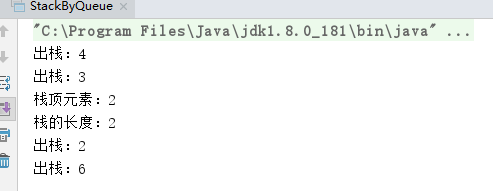用两个栈实现队列:
思想:比如 栈stack1,栈stack2,
向stack1中push元素:1、2、3、4、5、6
将stack1中的元素都出栈pop,然后push进stack2中:6、5、4、3、2、1;
这样stack1中无元素,stack2中元素:6、5、4、3、2、1,
然后出栈的时候从stack2中出,1就会先出栈;这样就实现了先进先出的效果;
import java.util.Stack;
/*
* 用两个栈实现一个队列
* */
public class QueueByStack {
Stack<Integer> stack1=new Stack<>();
Stack<Integer> stack2=new Stack<>();
public void add(Integer num){
stack1.push(num);
}
public Integer poll(){
/*当第二个栈stack2是空时,将栈stack1中的元素全部出栈放到stack2中,此时最先进入到栈stack1中的元素就会被放到最顶端,就会在stack2中先出栈*/
if (stack2.isEmpty()){
while (!stack1.isEmpty()) {
stack2.push(stack1.pop());
}
}
return stack2.pop();
}
public Integer size(){
return stack1.size()+stack2.size();
}
public Integer peek(){
/*栈stack2中的栈顶元素就是最先进入栈stack1中的元素*/
if (stack2.isEmpty()){
while (!stack1.isEmpty()) {
stack2.push(stack1.pop());
}
}
return stack2.peek();
}
public static void main(String[] args) {
QueueByStack queue=new QueueByStack();
queue.add(1);
queue.add(2);
queue.add(3);
queue.add(4);
queue.add(5);
System.out.println("出队列:"+queue.poll());
System.out.println("出队列:"+queue.poll());
System.out.println("出队列:"+queue.poll());
queue.add(6);
queue.add(7);
System.out.println("队列长度"+queue.size());
System.out.println("队列顶部元素:"+queue.peek());
System.out.println("出队列:"+queue.poll());
System.out.println("出队列:"+queue.poll());
System.out.println("出队列:"+queue.poll());
}
}
结果:

用一个队列实现栈:
思想:队列queue1;
向队列中add元素:1、2、3、4、5、6
要想实现先进后出的效果,就将1、2、3、4、5(除了最后一个元素),这前面的元素都先出(poll)队列,然后再add进队列;
队列中元素就变成了6、5、4、3、2、1;这样子出元素时,就是6先出(最后进入的先出),实现了队列的效果;
每一次出队列的时候都这样进行;
import java.util.LinkedList;
import java.util.Queue;
/*
* 用队列实现栈
*
* */
public class StackByQueue {
Queue<Integer> queue=new LinkedList<>();
public void push(Integer num){
queue.add(num);
}
public Integer pop(){
/*将队列前面的元素(除了最后一个元素)都先出队列,再进队列,这样最后一个元素就变成了队列中的首位,这样子,最后一个进队列的就会先出队列*/
for(int i=0;i<queue.size()-1;i++) {
queue.add(queue.poll());
}
return queue.poll();
}
public Integer size(){
return queue.size();
}
public Integer peek(){
if(queue.size()==0){
return null;
}
/*将队列前面的元素(除了最后一个元素)都先出队列,再进队列,这样子最后一个元素就会成为队列的首元素*/
for(int i=0;i<queue.size()-1;i++) {
queue.add(queue.poll());
}
Integer result=queue.peek();//此时的栈顶元素
queue.add(queue.poll());//要再将栈顶元素还原到它原本的位置(队列中最后),要不然在进行pop操作时,就会进行两次上面的“出队列,再进队”列操作
return result;
}
public static void main(String[] args) {
StackByQueue stack=new StackByQueue();
stack.push(1);
stack.push(2);
stack.push(3);
stack.push(4);
System.out.println("出栈:"+stack.pop());
System.out.println("出栈:"+stack.pop());
System.out.println("栈顶元素:"+stack.peek());
System.out.println("栈的长度:"+stack.size());
System.out.println("出栈:"+stack.pop());
stack.push(5);
stack.push(6);
System.out.println("出栈:"+stack.pop());
}
}
结果:






















 658
658











 被折叠的 条评论
为什么被折叠?
被折叠的 条评论
为什么被折叠?








